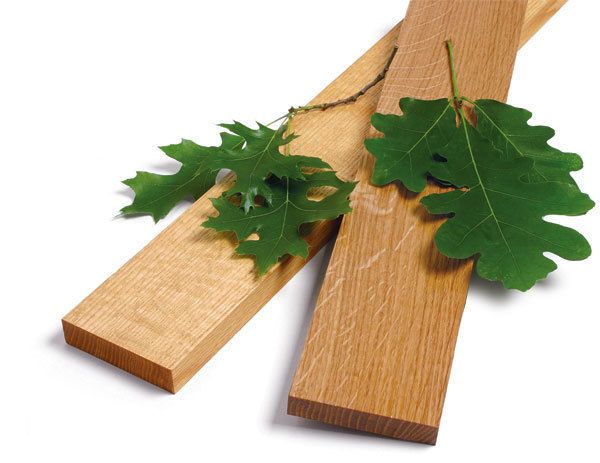What’s the Difference: White Oak vs. Red Oak
Two varieties differ in pore size, leaf shape, and clearly wood color
There are more than 60 species of oak growing in the United States, divided primarily into two groups: red and white. Both types grow mostly in the eastern half of the country and are easily distinguishable by their long, scalloped leaves: sharp-edged for red oak (left in photo), round-edged for white (right in photo).
Red-oak pores are large, and if you placed one end of a red-oak stick into soapy water and blew air through the other end, you would produce bubbles. Not so with white oak, which contains globular obstructions that block the easy passage of air and moisture. These globules, called tyloses, also fight bacteria, inhibiting decay and making white oak a better choice for outdoor projects.

Red oak. Its reddish cast distinguishes it from white oak.
Red oak is often very clear, straight-grained, and without defects. This makes it ideal for riven parts, such as the steam-bent arms and back bows of Windsor chairs. When milled, red oak has a warm, reddish cast that makes it a popular wood for a variety of household and office uses, from flooring to wall cabinets. However, largely because it is so common in public settings, red oak is less popular than white for fine furniture.

White oak. It lacks the reddish cast of red oak, but colors vary in tone, light to dark, even within each species.
Milled white oak has a tannish cast. It ages beautifully, developing a tawny patina in a short time. When quartersawn, it’s the wood of choice for Mission and Arts and Crafts furniture because of its distinctive figure, which features a beautiful ray-fleck pattern. Quartersawn red oak also exhibits a distinct, if more modest, ray-fleck pattern.
Lumberyard prices for flatsawn oak range from about $2.25 to $3.50 per board foot, with white oak usually the more expensive. This holds true for quartersawn oak as well, with white oak topping out at about $6 per board foot.
Furniture Friendly
Both red and white oak are used in fine furniture.


The organizer (left) is in red oak. The tables are white oak, fumed with ammonia to darken the wood and bring out the ray-fleck pattern.
From Fine Woodworking #194
Photos: Charlie Reina (wood); Kelly J. Dunton (tables); Michael Pekovich (cabinet)
Fine Woodworking Recommended Products

DeWalt 735X Planer

AnchorSeal Log and Lumber End-Grain Sealer

Ridgid R4331 Planer






















Comments
Hey Guys!
As a wood guy and huge white oak fan, I feel obligated to point out that the images on page 56 might be a tad askew. The quarter sawn and rift sawn end grain pics appear to be swapped!
Thanks for an otherwise great magazine!
Regards,
Andy
Log in or create an account to post a comment.
Sign up Log in